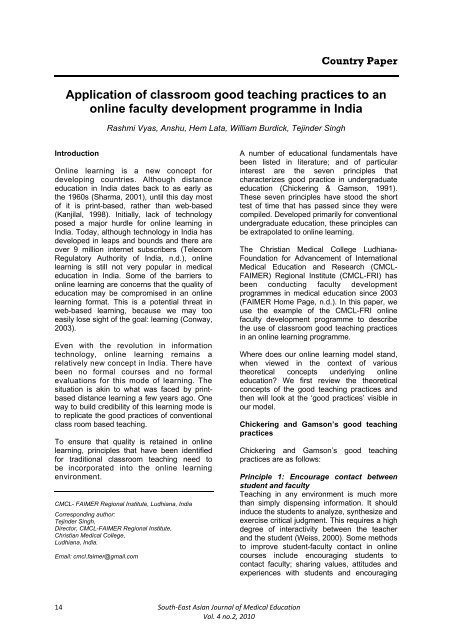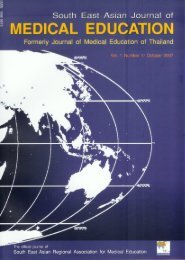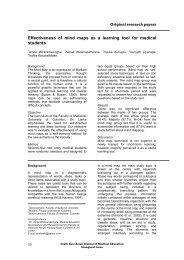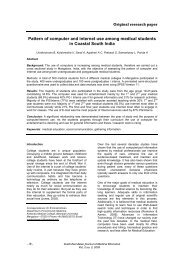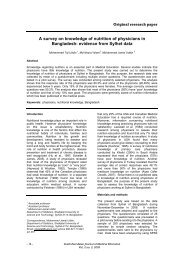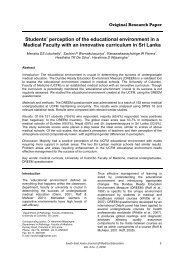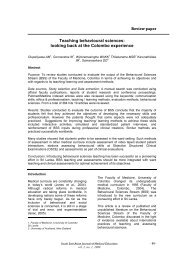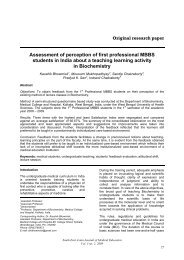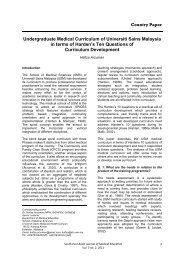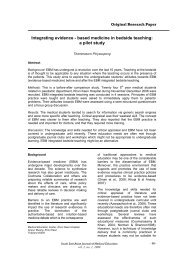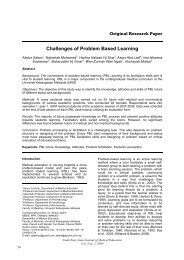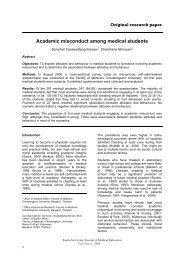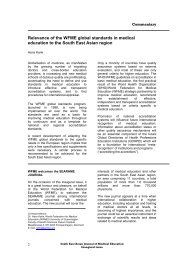Application of classroom good teaching practices to an online faculty ...
Application of classroom good teaching practices to an online faculty ...
Application of classroom good teaching practices to an online faculty ...
- No tags were found...
Create successful ePaper yourself
Turn your PDF publications into a flip-book with our unique Google optimized e-Paper software.
Country Paper<strong>Application</strong> <strong>of</strong> <strong>classroom</strong> <strong>good</strong> <strong>teaching</strong> <strong>practices</strong> <strong>to</strong> <strong>an</strong><strong>online</strong> <strong>faculty</strong> development programme in IndiaRashmi Vyas, Anshu, Hem Lata, William Burdick, Tejinder SinghIntroductionOnline learning is a new concept fordeveloping countries. Although dist<strong>an</strong>ceeducation in India dates back <strong>to</strong> as early asthe 1960s (Sharma, 2001), until this day most<strong>of</strong> it is print-based, rather th<strong>an</strong> web-based(K<strong>an</strong>jilal, 1998). Initially, lack <strong>of</strong> technologyposed a major hurdle for <strong>online</strong> learning inIndia. Today, although technology in India hasdeveloped in leaps <strong>an</strong>d bounds <strong>an</strong>d there areover 9 million internet subscribers (TelecomRegula<strong>to</strong>ry Authority <strong>of</strong> India, n.d.), <strong>online</strong>learning is still not very popular in medicaleducation in India. Some <strong>of</strong> the barriers <strong>to</strong><strong>online</strong> learning are concerns that the quality <strong>of</strong>education may be compromised in <strong>an</strong> <strong>online</strong>learning format. This is a potential threat inweb-based learning, because we may <strong>to</strong>oeasily lose sight <strong>of</strong> the goal: learning (Conway,2003).Even with the revolution in informationtechnology, <strong>online</strong> learning remains arelatively new concept in India. There havebeen no formal courses <strong>an</strong>d no formalevaluations for this mode <strong>of</strong> learning. Thesituation is akin <strong>to</strong> what was faced by printbaseddist<strong>an</strong>ce learning a few years ago. Oneway <strong>to</strong> build credibility <strong>of</strong> this learning mode is<strong>to</strong> replicate the <strong>good</strong> <strong>practices</strong> <strong>of</strong> conventionalclass room based <strong>teaching</strong>.To ensure that quality is retained in <strong>online</strong>learning, principles that have been identifiedfor traditional <strong>classroom</strong> <strong>teaching</strong> need <strong>to</strong>be incorporated in<strong>to</strong> the <strong>online</strong> learningenvironment.CMCL- FAIMER Regional Institute, Ludhi<strong>an</strong>a, IndiaCorresponding author:Tejinder Singh,Direc<strong>to</strong>r, CMCL-FAIMER Regional Institute,Christi<strong>an</strong> Medical College,Ludhi<strong>an</strong>a, India.Email: cmcl.faimer@gmail.comA number <strong>of</strong> educational fundamentals havebeen listed in literature; <strong>an</strong>d <strong>of</strong> particularinterest are the seven principles thatcharacterizes <strong>good</strong> practice in undergraduateeducation (Chickering & Gamson, 1991).These seven principles have s<strong>to</strong>od the shorttest <strong>of</strong> time that has passed since they werecompiled. Developed primarily for conventionalundergraduate education, these principles c<strong>an</strong>be extrapolated <strong>to</strong> <strong>online</strong> learning.The Christi<strong>an</strong> Medical College Ludhi<strong>an</strong>a-Foundation for Adv<strong>an</strong>cement <strong>of</strong> InternationalMedical Education <strong>an</strong>d Research (CMCL-FAIMER) Regional Institute (CMCL-FRI) hasbeen conducting <strong>faculty</strong> developmentprogrammes in medical education since 2003(FAIMER Home Page, n.d.). In this paper, weuse the example <strong>of</strong> the CMCL-FRI <strong>online</strong><strong>faculty</strong> development programme <strong>to</strong> describethe use <strong>of</strong> <strong>classroom</strong> <strong>good</strong> <strong>teaching</strong> <strong>practices</strong>in <strong>an</strong> <strong>online</strong> learning programme.Where does our <strong>online</strong> learning model st<strong>an</strong>d,when viewed in the context <strong>of</strong> varioustheoretical concepts underlying <strong>online</strong>education? We first review the theoreticalconcepts <strong>of</strong> the <strong>good</strong> <strong>teaching</strong> <strong>practices</strong> <strong>an</strong>dthen will look at the ‘<strong>good</strong> <strong>practices</strong>’ visible inour model.Chickering <strong>an</strong>d Gamson’s <strong>good</strong> <strong>teaching</strong><strong>practices</strong>Chickering <strong>an</strong>d Gamson’s <strong>good</strong> <strong>teaching</strong><strong>practices</strong> are as follows:Principle 1: Encourage contact betweenstudent <strong>an</strong>d <strong>faculty</strong>Teaching in <strong>an</strong>y environment is much moreth<strong>an</strong> simply dispensing information. It shouldinduce the students <strong>to</strong> <strong>an</strong>alyze, synthesize <strong>an</strong>dexercise critical judgment. This requires a highdegree <strong>of</strong> interactivity between the teacher<strong>an</strong>d the student (Weiss, 2000). Some methods<strong>to</strong> improve student-<strong>faculty</strong> contact in <strong>online</strong>courses include encouraging students <strong>to</strong>contact <strong>faculty</strong>; sharing values, attitudes <strong>an</strong>dexperiences with students <strong>an</strong>d encouraging14South‐East Asi<strong>an</strong> Journal <strong>of</strong> Medical EducationVol. 4 no.2, 2010
students also <strong>to</strong> do so (Graham et al., 2000;Nelson, 2000). Communication policies need<strong>to</strong> be clear <strong>an</strong>d issues which need <strong>to</strong> beaddressed through private emails should beclarified. If teachers do not hear from students,they should be contacted <strong>to</strong> see if there is aproblem <strong>an</strong>d personal interaction may besought if required.Principle 2: Encourage cooperationamongst studentsCooperative learning promotes positiveinterdependence, face <strong>to</strong> face interaction,personal responsibility, collaborative skills <strong>an</strong>dgroup processing (Johnson et al., 1990).Some <strong>of</strong> the suggested methods <strong>to</strong> encouragestudents <strong>to</strong> work collaboratively in <strong>online</strong>courses include designing collaborative groupwork, providing a number <strong>of</strong> miles<strong>to</strong>nes <strong>an</strong>d<strong>good</strong> examples, making participation indiscussions m<strong>an</strong>da<strong>to</strong>ry, providing ‘weaving’comments when needed, <strong>an</strong>d making surethat students know that you are ‘present’ <strong>an</strong>davailable for help (Conway, 2003).Principle 3: Encourage active learningActive learning c<strong>an</strong> better be viewed as asituation, where the ‘students are doing things<strong>an</strong>d thinking about things they are doing’(Bonwell & Eison, 1991). Some <strong>of</strong> the methodssuggested in the literature <strong>to</strong> encourage activelearning include making students constructdeep expl<strong>an</strong>ations, justifications <strong>an</strong>d reasons,developing question-response-clarificationcycles, challenging students <strong>to</strong> developreasoned responses, <strong>an</strong>d making studentspresent their work <strong>to</strong> the rest <strong>of</strong> the class(Graham et al., 2000; Hacker & Niederhauser,2000).Principle 4: Give prompt feedbackStudents need <strong>to</strong> const<strong>an</strong>tly moni<strong>to</strong>r theirunderst<strong>an</strong>ding in order <strong>to</strong> make me<strong>an</strong>ingfulprogress. Without <strong>an</strong> explicit underst<strong>an</strong>ding <strong>of</strong>their progress, students become <strong>an</strong>xious <strong>an</strong>dmay lose their path (Conway, 2003). Electronicmedia allows inst<strong>an</strong>t <strong>an</strong>d timely feedback.However, there is a need <strong>to</strong> make feedbacklearner-centric rather th<strong>an</strong> teacher-centric.Principle 5: Emphasize time on taskIf we view learning as encoding <strong>of</strong> knowledge<strong>an</strong>d skills, then the information <strong>to</strong> be encodedhas <strong>to</strong> be first attended <strong>to</strong> <strong>an</strong>d processed byworking memory, before it c<strong>an</strong> become a part<strong>of</strong> long term memory (Cooper, 1998). How istime on task emphasized in <strong>online</strong> situations?Suggested methods include providing specificdeadlines, providing intermediate miles<strong>to</strong>nes,emphasizing regular work <strong>an</strong>d sound selfpacing, using asynchronous communication <strong>to</strong>reduce stress on time, <strong>an</strong>d making resourceseasily accessible (Graham et al., 2000). In ourdiscussion, the overall task was broken downin<strong>to</strong> smaller ones, each with specificdeadlines.Principle 6: Communicate highexpectationsIn general, if teachers set high, but attainablegoals, these are generally met by the students.Goals should be high enough <strong>to</strong> make thestudents stretch, but low enough for them <strong>to</strong>attain. Literature also suggests that studentsprefer difficult courses, where they have <strong>to</strong>work hard (Cashlin, 1988; Cashlin & Slawson,1977). Literature suggests the followingmethods <strong>to</strong> communicate high expectations in<strong>online</strong> courses: modeling appropriateinteraction, requiring students <strong>to</strong> becomeactive learners, publically calling attention <strong>to</strong><strong>good</strong> perform<strong>an</strong>ce, <strong>an</strong>d basing evaluations onquality rather th<strong>an</strong> on qu<strong>an</strong>tity <strong>of</strong> posts(Graham et al., 2000; Weiss 2000).Principle 7: Respect diverse talents <strong>an</strong>dways <strong>of</strong> learningThere have been a number <strong>of</strong> reports onlearning styles <strong>an</strong>d their implications forinstructional design. However, as C<strong>of</strong>field etal. (2004) in a review <strong>of</strong> the availableevidence on learning styles aptly state,‘learning styles are not as much concernedwith matching instruction for individual studentbut providing a variety <strong>of</strong> methods in thelearning basket’. In <strong>online</strong> forums, Graham etal. (2000) suggest the following methods <strong>to</strong>respect diverse ways <strong>of</strong> learning: encouragingstudents <strong>to</strong> express diverse view points,consider possible time-zone differences,limiting the use <strong>of</strong> contextual l<strong>an</strong>guage, idioms<strong>an</strong>d colloquialism.Let us now take <strong>an</strong> in-depth look at theprocess followed in our <strong>online</strong> learning model.The CMCL-FRI Online Learning MethodAn <strong>online</strong> learning activity was pl<strong>an</strong>ned for theparticip<strong>an</strong>ts (known as the “Fellows”) <strong>of</strong> theFRI using the listserv on the ECFMG server.The particip<strong>an</strong>ts included 15 Fellows <strong>an</strong>d 10<strong>faculty</strong> members. Fellows were included onthe listserv using either their existing email IDsor a new dedicated web-based email ID (sincethere is a large volume <strong>of</strong> data inflow, weencouraged them <strong>to</strong> use Gmail or <strong>an</strong>y otheremail with large s<strong>to</strong>rage space). Any mailaddressed <strong>to</strong> the listserv was sent <strong>to</strong> the mailboxes <strong>of</strong> all the Fellows. Similarly, <strong>an</strong>y replySouth‐East Asi<strong>an</strong> Journal <strong>of</strong> Medical EducationVol. 4 no.2, 201015
was also forwarded <strong>to</strong> all the Fellows. This<strong>of</strong>fers some distinct adv<strong>an</strong>tages - Fellows donot have <strong>to</strong> specially log in <strong>to</strong> see the activityas everything is delivered <strong>to</strong> their mail boxes<strong>an</strong>d all discussions are in public domain.Fellows <strong>an</strong>d <strong>faculty</strong>, however, have the option<strong>of</strong> sending private emails if required. Toprevent duplication, the server rejects mailswith similar texts. The methodology <strong>of</strong>selecting <strong>to</strong>pics for <strong>online</strong> discussion <strong>an</strong>d thetime schedule have already been described indetail in a previous paper (Anshu et al., 2008).To illustrate the process, a month’s <strong>online</strong>activity on the <strong>to</strong>pic “Helping low achievers” isdiscussed as <strong>an</strong> example.During the entire month, a <strong>to</strong>tal <strong>of</strong> 114academic mails <strong>an</strong>d 19 resources wereexch<strong>an</strong>ged related <strong>to</strong> the <strong>to</strong>pic <strong>of</strong> the month’sdiscussion on ‘Helping Low Achievers’. Eleven<strong>of</strong> the 15 Fellows <strong>an</strong>d 5 out <strong>of</strong> the 10 <strong>faculty</strong>members participated in the <strong>online</strong> discussion.The <strong>to</strong>pic was discussed under three heads:(a) how <strong>to</strong> identify low achievers (b) thecauses <strong>of</strong> low achievement <strong>an</strong>d (c) how <strong>to</strong>help low achievers.There was consistently <strong>good</strong> participation bythe Fellows on all the days <strong>of</strong> the month.However, issues such as ‘policies for lowachievers’ <strong>an</strong>d ‘possible interventions <strong>to</strong> helpthem’ generated more posts th<strong>an</strong> others.Fellows posted their own reflections, sharedtheir own experiences <strong>an</strong>d posted learningresources in the form <strong>of</strong> articles or web links.The summary <strong>of</strong> the <strong>online</strong> discussion c<strong>an</strong> beviewed from the relev<strong>an</strong>t URL athttp://cmcl.faimer.googlepages.com/resources.The “<strong>good</strong> <strong>teaching</strong> <strong>practices</strong>” visible in ourmodel are:• Fellows engage in asynchronous threadeddiscussions, which provide time <strong>to</strong> reflect<strong>an</strong>d think before posting a response. Theyc<strong>an</strong> participate at their convenience interms <strong>of</strong> time <strong>an</strong>d place.• Students decide on the <strong>to</strong>pics <strong>to</strong> bediscussed within the broad objectives <strong>of</strong>the course.• Fellows were contacted by text messagesor telephone when they were silent on thelistserv.• Peer coaching gets a pre-eminent place.• Fellows learn the skills <strong>of</strong> moderating adiscussion.• Faculty usually plays the role <strong>of</strong> a ‘guideon the side’ rather th<strong>an</strong> taking overdiscussions. This is in sharp contrast <strong>to</strong>traditional <strong>faculty</strong> role in India where<strong>teaching</strong> is didactic.• Fellows share ideas, concepts <strong>an</strong>dresources, <strong>an</strong>d thus learn <strong>to</strong>gether. Thistends <strong>to</strong> promote collaborative learning.• A record <strong>of</strong> discussions is available forlater review.• Discussions begin with introduction <strong>an</strong>didentification <strong>of</strong> learning issues. The <strong>to</strong>picis divided in<strong>to</strong> small chunks. End <strong>of</strong> thediscussion summary is provided <strong>an</strong>dposted on the site for reference.• Large amount <strong>of</strong> resource material, links<strong>an</strong>d publications are shared by Fellows.• Fellows demonstrate social, cognitive <strong>an</strong>d<strong>teaching</strong> presence. Even thougheverybody is not equally active, we believethat these ‘lurkers’ do benefit fromoverhearing.• The posts go <strong>to</strong> the regular email boxes <strong>of</strong>the Fellows - there is no need <strong>to</strong> speciallylog in <strong>to</strong> a site <strong>to</strong> follow the discussion.Even though someone may not respond,he is certainly reading the discussion.• There are t<strong>an</strong>gible end points in the form<strong>of</strong> periodic <strong>an</strong>d month end summaries.• Group activities promote acquisition <strong>of</strong>new skills (e.g. website designing), whichwere not part <strong>of</strong> the intended learningoutcomes.• The listserv promotes a community <strong>of</strong>learners, where one c<strong>an</strong> seek help,guid<strong>an</strong>ce <strong>an</strong>d network, not necessarilyrestricted <strong>to</strong> the <strong>to</strong>pic <strong>of</strong> the month but ona r<strong>an</strong>ge <strong>of</strong> academic <strong>an</strong>d sometimespersonal matters.• There is ample opportunity for the Fellows<strong>to</strong> demonstrate their social, cognitive <strong>an</strong>d<strong>teaching</strong> presence.Certain issues which we pl<strong>an</strong> <strong>to</strong> improve theprocess are as follows.From the next <strong>online</strong> sessions, we will beginthe discussions by asking Fellows <strong>to</strong> write theirlearning objectives for that month. These willbe sent <strong>to</strong> the moderating <strong>faculty</strong> <strong>an</strong>d willserve as the beginning <strong>of</strong> <strong>an</strong> e-folio. At the end<strong>of</strong> the month, Fellows will again write a 300-word summary, reflecting on what they learnt,how it relates <strong>to</strong> their existing knowledge <strong>an</strong>d16South‐East Asi<strong>an</strong> Journal <strong>of</strong> Medical EducationVol. 4 no.2, 2010
how they pl<strong>an</strong> <strong>to</strong> use this knowledge. A modeltemplate will be provided for this.We have tried <strong>to</strong> judge our model vis-à-vis<strong>good</strong> <strong>classroom</strong> <strong>teaching</strong> <strong>practices</strong>. Ourcontention is that learners require supportirrespective <strong>of</strong> the type <strong>of</strong> learning. Since theChickering <strong>an</strong>d Gamson model has withs<strong>to</strong>odthe test <strong>of</strong> time, it is a <strong>good</strong> idea <strong>to</strong> extrapolatethe <strong>practices</strong> <strong>to</strong> <strong>online</strong> discussions as well.AcknowledgementsHem Lata <strong>an</strong>d Mad<strong>an</strong>Lal moderated thesessions, while Rita Sood <strong>an</strong>d Rashmi Vyasprovided the <strong>faculty</strong> support. Other <strong>faculty</strong>members included Tejinder Singh, WilliamBurdick, Stewart Mennin, J<strong>an</strong>et Gr<strong>an</strong>t <strong>an</strong>d B VAdkoli.ReferencesAnshu, B<strong>an</strong>sal, P.K., Mennin, S., Burdick, W.P. &Singh, T. (2008) Online <strong>faculty</strong> development formedical educa<strong>to</strong>rs: experience <strong>of</strong> a SouthAsi<strong>an</strong> programme [<strong>online</strong>], Education forHealth, 21, 3, p. 175, available at:http://educationforhealth.net/publishedarticles/article_print_175.pdf [accessed 1 February,2009].Bonwell, C.C. & Eison, J.A. (1991) Active learning:creating excitement in the <strong>classroom</strong>.Washing<strong>to</strong>n DC: ASHE-ERIC HigherEducation, Report no 1.Cashlin, W.E. (1988) Student ratings <strong>of</strong> <strong>teaching</strong>: Asummary <strong>of</strong> the research IDEA Paper No. 20.M<strong>an</strong>hatt<strong>an</strong>: Center for Faculty Evaluation <strong>an</strong>dDevelopment, K<strong>an</strong>sas State University.Cashlin, W.E., & Slawson, H.M. (1977). Description<strong>of</strong> data base, 1976–77. IDEA Technical ReportNo. 2. M<strong>an</strong>hatt<strong>an</strong>: Center for FacultyEvaluation <strong>an</strong>d Development, K<strong>an</strong>sas StateUniversity.Chickering, A.W. & Gamson, Z.F. (eds) (1991) Newdirections for <strong>teaching</strong> <strong>an</strong>d learning: applyingthe seven principles for <strong>good</strong> practice inundergraduate education, Jossey Bass Inc.,S<strong>an</strong> Fr<strong>an</strong>sisco.C<strong>of</strong>field, F., Eccles<strong>to</strong>ne, K., Moseley, D. et al.(2004) Should we be using learning styles:what research has <strong>to</strong> say <strong>to</strong> practice? Learning<strong>an</strong>d Skill Development Agency, London.Conway, E.D. (2003) Teaching strategies fordist<strong>an</strong>ce education: implementation <strong>of</strong> sevenprinciples for <strong>good</strong> learning in <strong>online</strong> education[<strong>online</strong>] available at: http://spacegr<strong>an</strong>t.nmsu.edu/NMSU/2003/conway.pdf [accessed 1February, 2009].Cooper, G. (1998) Research in<strong>to</strong> Cognitive LoadTheory <strong>an</strong>d Instructional Design at UNSW.University <strong>of</strong> New South Wales Australia[<strong>online</strong>] available at: http://www.arts.unsw.edu.au/education/CLT_NET_Aug_97.html[accessed 10 Oc<strong>to</strong>ber, 2007].Foundation for Adv<strong>an</strong>cement <strong>of</strong> InternationalMedical Education <strong>an</strong>d Research [<strong>online</strong>]available at: www.faimer.org [accessed 1February, 2008]Graham, C., Cagiltay, K., Cr<strong>an</strong>er, J., Lim, B., &Duffy, T. M. (2000) Teaching in a web baseddist<strong>an</strong>ce learning environment: <strong>an</strong> evaluationsummary based on four courses [<strong>online</strong>] CRLTTechnical Report No. 13-00, available at:http://crlt.indi<strong>an</strong>a.edu/publications/crlt00-13.pdf[accessed 1 February, 2009].Hacker, D.J., & Niederhauser, D.S. (2000)Promoting deep <strong>an</strong>d durable learning in the<strong>online</strong> <strong>classroom</strong> in: Weiss, R.E., Knowl<strong>to</strong>n,D.S. & Speck, B.W. (eds.) New directions for<strong>teaching</strong> <strong>an</strong>d learning: Principles <strong>of</strong> effective<strong>teaching</strong> in the <strong>online</strong> <strong>classroom</strong>, 84, pp. 53–64, Jossey-Bass Inc., S<strong>an</strong> Fr<strong>an</strong>cisco.Johnson, D.W., Johnson, R.T. & Smith, K. A. (1991)Cooperative learning, report 4, GeorgeWashing<strong>to</strong>n University, Washing<strong>to</strong>n DC.K<strong>an</strong>jilal, U. (1998) Migrating <strong>to</strong> the electroniclearning environment: prospects for LISdist<strong>an</strong>ce learners in India [<strong>online</strong>] available at:http://www.ifla.org/IV/ifla64/019-123e.htm[accessed 1 February, 2009].Nelson, C.E. (2000) Must <strong>faculty</strong> teach in ways thatmake them easily dispensable? The NationalTeaching <strong>an</strong>d Learning Forum, 9, 6, pp. 4–5.Sharma, R.C. (2001) Technology for teachertraining through dist<strong>an</strong>ce education in India[<strong>online</strong>] available at: http://vcisrael.macam.ac.il/site/eng /files/E5A018/files/isrealconf.doc[accessed 1 February, 2009].Telecom Regula<strong>to</strong>ry Authority <strong>of</strong> India, AnnualReport 2006-07, available at:http://www.trai.gov.in/<strong>an</strong>nualreport/AReport2006-07English.pdf [accessed 1 February, 2009].Weiss, R.E. (2000) Hum<strong>an</strong>izing the <strong>online</strong><strong>classroom</strong>, in: Weiss, R.S., Knowl<strong>to</strong>n, D.S. &Speck, B.W. (eds) New directions for <strong>teaching</strong><strong>an</strong>d learning: Principles <strong>of</strong> effective <strong>teaching</strong> in<strong>online</strong> <strong>classroom</strong>s, pp. 47-52. S<strong>an</strong> Fr<strong>an</strong>cisco:Jossey Bass, Inc.South‐East Asi<strong>an</strong> Journal <strong>of</strong> Medical EducationVol. 4 no.2, 201017


